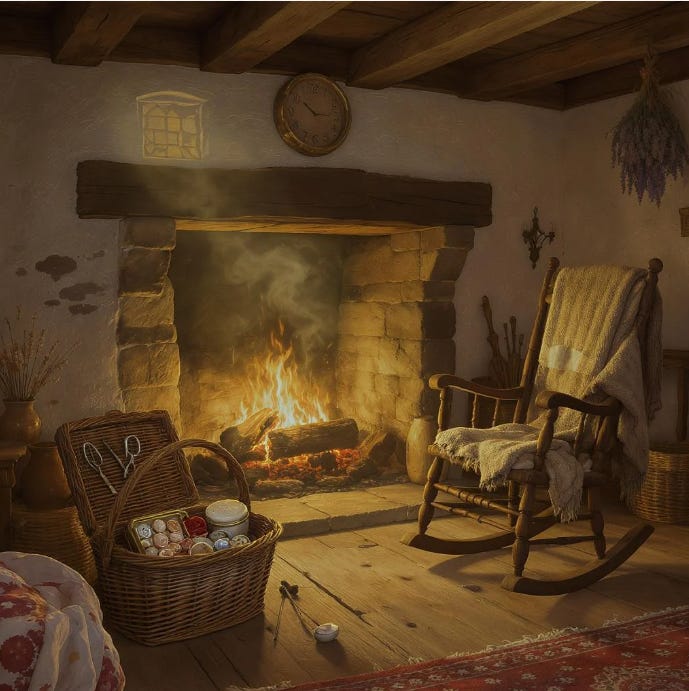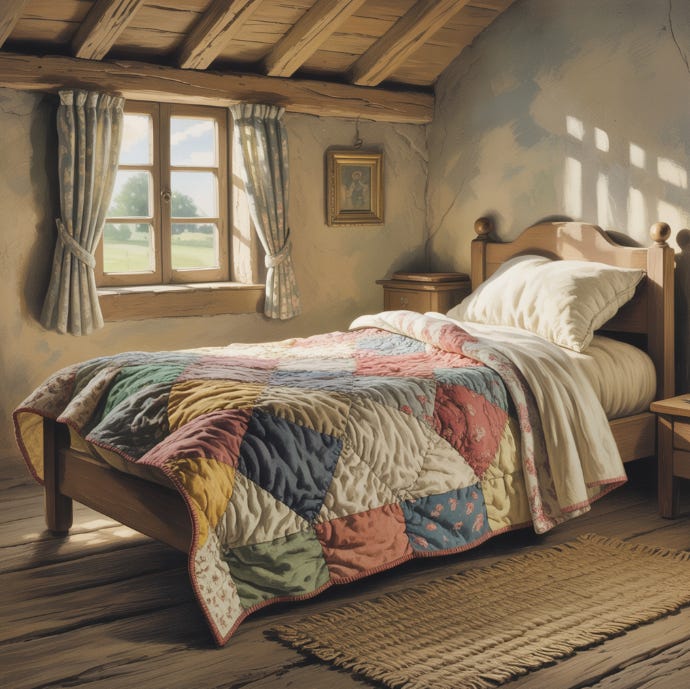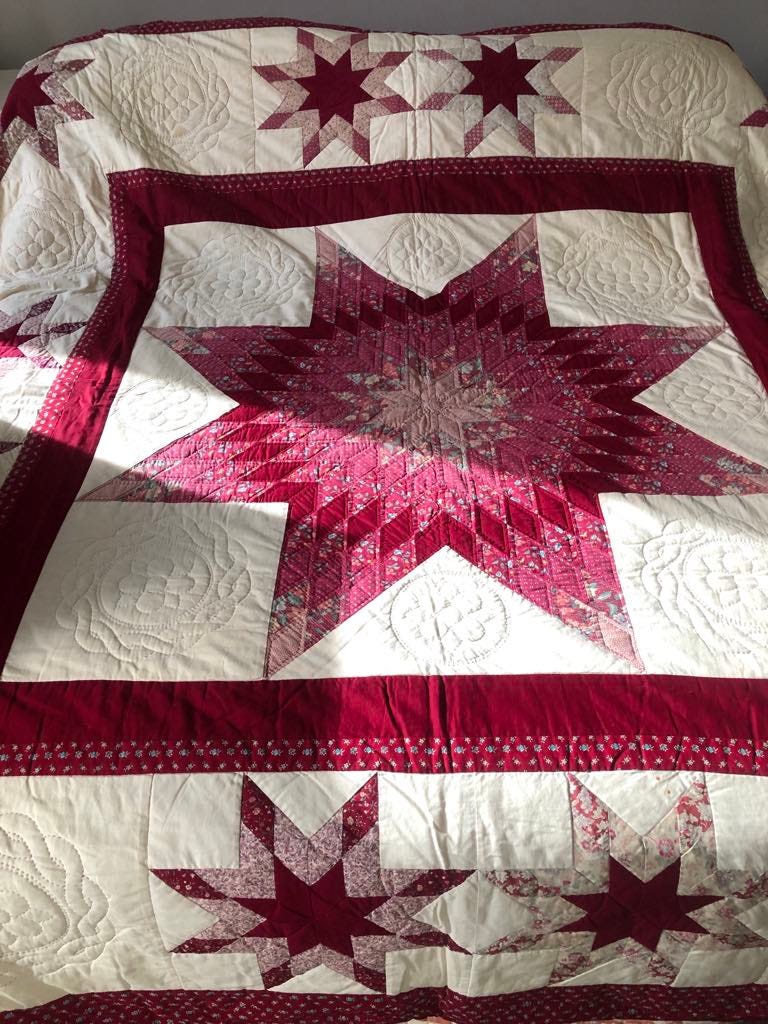Image by Flux-1 Kontext, at Abacus.ai June 2025
Questions for Harriet: 🌿 Harriet Allery (1819–1888) — Totnes, Devon!
My imagined visit to her in a modest cottage in the 1870s, a widow reflecting on a life of rural devotion, continues.
What was it like to marry at fifteen—were you frightened, excited, or both? How did you manage a household with so little and still raise three children? When you go to the Totnes market, what do you look forward to most? Do you remember a moment in your life as an Innkeeper's wife when you felt truly proud? What remedies or cures did your mother teach you that still serve your family? How did you feel when the railway came through—hopeful, or wary of change? If you could choose one hymn to be sung at your funeral, which would it be? What do you miss most about the way things were when your husband was still there? What were your favourite pastimes, especially in the evenings? What do you hope your children remember most about you?
Chapter 9: The Sewing Basket
“A well-mended hem says you love someone. Needles speak in ways words can’t.”
My sewing basket was never far from reach. It sat beside the hearth or rested on my lap as the light faded and the fire cracked low. Inside it lived all my quiet tools: bone-handled scissors with one blade dulled from use, thimbles worn smooth from years of pressing, a biscuit tin filled with buttons of every kind, and my velvet pincushion—bald now at the corners, but still loyal.
To some, it may have looked like ordinary housework. But to me, every stitch was a kind of prayer. A hem turned up, a button sewn tight, a cuff repaired—these were my ways of saying I see you, I care, and you matter.
When Samuel snagged his coat on the hedgerow, I patched it with wool as close to the original as I could find. When the children grew too fast for their frocks or came home with holes in the knees, I let out seams, added fabric, or reinforced the worn places.
I always said, a careful mend is a mother’s love made visible.
I stitched while the bread baked, while the kettle warmed, and while one of the children sounded out words from the Bible or a dog-eared storybook. Even when a neighbour dropped by, I often kept the needle moving as we spoke—my hands working even as my ears listened. Some of my finest work you’d never notice—tiny hidden stitches beneath collars, hems invisibly mended, linings strengthened from within. Quiet work. But then, love often is.
The basket held more than thread. It held memories. A patch from John’s first school trousers. A corner of lace from the shift I wore on my wedding day. Scraps from baby gowns are now yellowed but too dear to throw away. As I grew older, I began piecing together a quilt—nothing grand, just small bits of cloth from every chapter of life. It was meant to warm more than bodies. It was meant to tell a story—mine.
I stitched it slowly, in silence. Each square is a memory. Each line of thread was a tether to someone I had loved.
Image by Ideogram 3.0 at Abacus.ai June 2025
My Quilt Collection
Perhaps I took after this great-grandmother in my quilting days. I have a stack of quilts in a hamper, stored carefully as heirlooms for my granddaughters. These only get an airing when I am displaying them for those interested. I remember taking a selection of them along to a Toastmasters meeting at which I was delivering a speech about the ancient craft. I remember the fabric selection, the planning, the piecing, the stitching, and the quilting that I put into each one.
In my collection, I have large bed-sized quilts and smaller wall hangings. Their themes include traditional Nine-Patch, Lone Star, Album Signature, and Friendship quilts.
My Lone Star quilt with Celtic quilting. I received several small Lone Star quilt patches from my quilting circle, and these were added to this large queen-sized quilt in the 1980s. Now stored in Grandma’s quilt box.
I think I must have spent a small fortune on special quilting fabrics over the years, and I spent many hours on the construction of each quilt. Many of them were given away as baby shower gifts for the babies of my nieces, and I still have plans for the creation of special quilts as gifts for my granddaughters when they marry. (I might have to get started on these real soon.)
Ms Perplexity Assists
Quilting is a centuries-old craft that beautifully weaves together utility, artistry, and storytelling. Here’s a concise overview of its history and a visual guide to popular patterns from different eras—perfect for an Australian, English, Scottish, or Welsh genealogy lens.
19th Century: Quilting in America and Britain evolved with distinctive styles:
Central medallion and whole cloth quilts showcased needlework skills.
Block-style quilts (like Nine Patch) became popular for their practicality and ease of assembly.
Appliqué and album quilts marked special occasions, while crazy quilts reflected Victorian tastes for embellishment and asymmetry.
Popular Quilt Patterns by Era
Below is a visual guide to classic patterns—while I can’t display images directly, I’ll describe each and suggest what to look for if you’re searching for visual references:
Stories of Quilts and Artefacts
I am building my family history archive at WeAre.xyz and creating articles about artefacts, such as my quilts, to share with my family.
Reflection Prompt:
Was there someone in your family who expressed love through making or mending? What items—quilts, blankets, aprons, shirts—carry emotional weight in your family’s history?










Beautiful, I love your quilt. Had friends who were avid quilters but it didn’t appeal to me. I spent all that money on clothing fabrics and sewed for myself, husband, children and then grandchildren. Have you downsized your material stash? Mine awaits a radical cull!
Love this story. My mother was an avid quilter. I’ve tried, made some small items but not attempted a quilt. I have three of her quilts, one is currently on our bed, the other two are Holly Hobby quilts she made for my girls. Fortunately I asked her to stitch her name and the year on the back in 1986. We lost her at 59 in 1988.